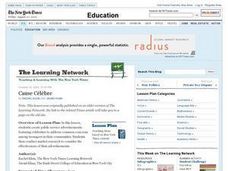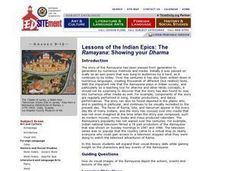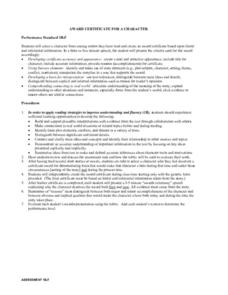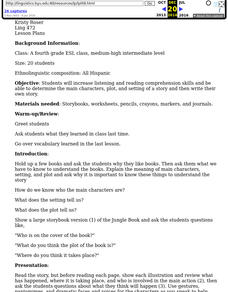Curated OER
Cause Célèbre
In this exercise, learners identify characters from an "Archie" comic and discuss the relevance of "Archie" to today's youth. They create public service advertisements featuring celebrities to address common concerns among teenagers in...
Curated OER
Lesson Plan 4: Creating Main Characters
Creating a good main character is a must when writing a creative narrative or novel. Elementary aged writers create main characters for the novel they are writing. They first use themselves as a models, then create a character as a...
Curated OER
Captivating Characters
Young scholars read a book on their own and identify the characteristics of fantasy literature. After finding quotes from their favorite characters, they use construction paper to make models of them. To end the lesson, they use...
Curated OER
CAN WE SWITCH GENDERS OF STORY CHARACTERS?
Analyze characters and stories to identify stereotyping. Learners will examine the concept of character gender to evaluate bias in classroom story books. They are asked to read a story or play and change the gender of the character to...
Curated OER
Theatrical Economics
Read then role-play the characters from story of If You Give A Pig a Pancake. Young actors use improvisation and characterization to create the characters from the story. They will also write and role play original version of the story...
Curated OER
How Characters Get What They Want
Sixth graders analyze the primary force that drives a character's actions in a character analysis lesson. In this character analysis lesson, 6th graders analyze how characters present their actions and participate in a group activity...
Curated OER
Mythological Word Origins
No wonder the ship was called the Titanic. An investigation of Norse, Roman, and Greek Mythology provides insight into mythological characters and corresponding words in the English language. A close look at roots, prefixes, and suffixes...
Curated OER
Big Pumpkin
Learners read a story and retell it through role playing. They will read Big Pumpkin, identify the main ideas and important characters, retell the story through dramatic play, and identify their favorite character.
Curated OER
Different Strokes For Different Folktales
Young readers use graphic organizers, such as Venn diagrams and story maps, to analyze a variety of folktales and the elements of a story. They use writing, sequencing activities, and creative art to identify the morals learned from a...
Curated OER
Convincing Characters
Young scholars create vivid, active characters for a story. In this character lesson, students discuss the characters in books they are familiar with. Young scholars create a list of novels they have read and discuss the character types....
Curated OER
Inferring Character Traits
Here is a lesson which is "flexible," and can operate as an individual or whole class activity. After reading a book of their choosing, with the use of a semantic map, learners identify character traits. They infer how their feelings...
Curated OER
Lesson Plan 10: Writing Really Good Dialogue
Boring dialogue can run a great story into the ground; get your novelists using dialogue as a tool to move their story into deeper and more developed territory. As part of a larger writing series, this instructional activity has a...
Curated OER
Pop-Up Puppets
Students read "Peter Spier's Circus!" and identify the literature's setting and characters. They work in small groups to create a circus stage set and puppets based on their reading. Students perform a puppet show using their set and...
Curated OER
Story Spinners
Students read a book orally using a "Snaking It" technique. The students make a curvy path around the room and take turns reading a sentence orally. They then create a project using paper plates and colored pencils to identify the main...
Curated OER
Character Traits in Fables
Combining art, music, dance, and reading comprehension, this lesson plan is geared to reach all ability levels. After reading a variety of fables and discussing story elements and character traits, class members select a moral to use as...
Curated OER
There Was An Old Lady...
First graders read "There Was An Old Lady Who Swallowed a Fly" and use Kid Pix to identify characters from the story. In this character identification lesson, 1st graders first hear several versions of the classic tale, and then locate...
Curated OER
Character Study
Third graders work in pairs to choose two characters and find their similarities and differences. In this character lesson, 3rd graders compare characters by their actions and attributes. Students individually complete a graphic...
Curated OER
What a Character!
Guide your readers to explore character traits. As a class, discuss and record the traits of a commonly-known fairy tale character. Then do the same with the main character in the class novel. Finally, have learners use magazines and...
Curated OER
Palace Adventure
Young language arts learners write and illustrate a short fantasy story based on the book Corduroy. First, learners need to develop a character. Then, through their writing and illustrations, they take their characters on adventures...
Curated OER
Irony in "The Gift of the Magi"
Use O. Henry's ubiquitous tale of love and poverty to explore irony. After reading the story, middle schoolers identify examples of all three kinds of irony in the story. With partners, they brainstorm original examples of irony. Then...
Curated OER
The Ramayana: Showing your Dharma
High schoolers identify characters and events from the Ramayana. They discuss ways in whcih the images convey non-verbal information and messages. They discuss similarities and differences in the visual and verbal tellings of the Ramayana.
Curated OER
AWARD CERTIFICATE FOR A CHARACTER
Connect to real-world experiences by having your primary learners create an award certificate based upon literal and inferential information from a story. They present the award to a character from a story and explain the criteria used....
Curated OER
Story Elements
Third graders identify story elements. In this story elements lesson, 3rd graders look at main idea, characters, point of view, theme and setting. They create a five paneled comic strip from a book.
Curated OER
Language Practice
The simple instructional techniques described in this plan will help young readers learn and practice basic reading skills and strategies. Before reading, introduce your readers to the meaning of main character, setting, and plot. Then...
Other popular searches
- Identify Characters Mood
- Identify Characters Actions
- Beowulf Identify Characters
- Identify Characters in a Story

























